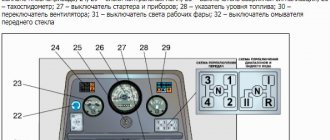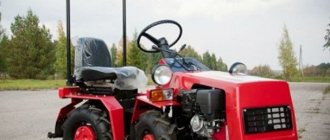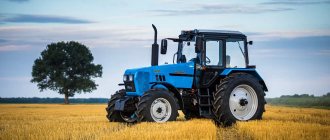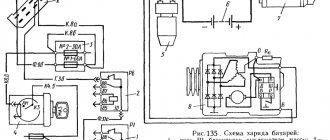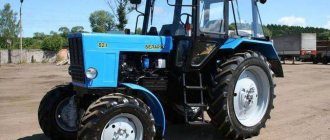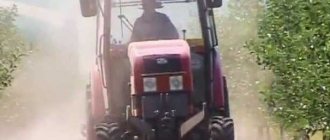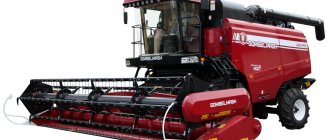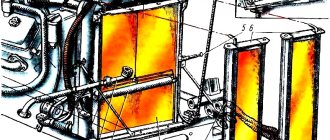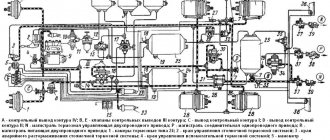- home
- Media center
- Articles
- Design of the MTZ-82 tractor
Menu
- News
- Articles
- Video materials
- Photo materials
- Publication in the media
- 3D tour
16.04.2021
MTZ-82 tractors are used in various fields of activity and are one of the most common in their class. This situation is explained by good performance, high reliability of the power unit, carefully thought-out design, versatility and long service life. Another important point is the maintainability of Belarus tractors. According to this criterion, Belarusian-made equipment is considered a leader, and determines the mass production of the vehicle, as well as a large selection of original and high-quality spare parts, components and consumables and their affordable cost.
Chassis design features
The MTZ-82 tractor was created on the basis of the Belarus-52 and has some design similarities with its earlier predecessor. But despite this, MTZ-82 can safely be called a unique agricultural machinery. The main advantages compared to the earlier model are:
- The ability to reduce the number of revolutions of the output shaft using a gearbox in the gearbox, increasing torque. Thanks to this, the off-road patency of the equipment is significantly improved, and also allows the transmission of torque to the PTO.
- Presence of creeper. Its use makes it possible to increase the number of gears to 11 (2 for moving backward and 9 forward), as well as improve speed performance. The reduction gearbox allows you to double the number of gears.
- The power take-off shaft is 2-speed. Thanks to this equipment, you can significantly expand the list of attachments used, making the equipment multifunctional and universal.
- A combination of good cross-country ability and higher crankshaft speed.
The design of the MTZ-82 tractor is made on the basis of a semi-frame structure, which consists of 2 channels, which are connected at the front by a cast beam. The tractor frame is rigid and includes the following elements:
- checkpoint;
- rear axle housing;
- 2 beams - longitudinal and transverse;
- clutch block.
Thanks to this suspension design, the process of removing and installing the engine, as well as aggregating attachments, is significantly simplified and takes much less time.
Technical parameters, operational characteristics
The versatility and versatility in use of the tractor are ensured by the following technical characteristics (parameters and descriptions for the manufactured modification are given):
- Traction class – 1.4
- Drive – four-wheel drive (4x4).
- Load capacity – 3.2 tons.
- Engine: model – D-243.
- type - four-cylinder diesel, with direct fuel injection, without turbocharging and liquid cooling:
- power – 81.0 l. With.,
- engine volume – 4.75 l,
- fuel consumption rate – 230 g/(kW h),
- weight – 0.43 t.
- wheelbase – 2.45 m,
- Gearbox – manual, stepped,
- type – universal, aggregate-separate,
- on the front axle – 11.20-20.
- weight – 3.5 t,
The technical characteristics and operational parameters inherent in the design allow high-quality agricultural work and other mechanized operations.
Chassis of the MTZ-82 tractor: main elements and their purpose
Structurally, the chassis of this model is made in the form of a trolley, consisting of assembly units, assemblies, mechanisms and individual parts intended for the movement of agricultural machinery: wheelbase, non-driving axle, frame (base where all structural elements are assembled).
From the front, the frame is equipped with cylindrical springs, which are located in the king pins of the front axle. The semi-frame consists of 2 spars and a durable metal beam secured with bolts. Brackets are attached to the rear of the side members by welding, connecting this structure to the clutch mechanism housing. The front beam is used to install the shutters of the power unit, main control wheels, engine support, oil and water radiators.
The front-wheel drive attachment from the gearbox is connected to the front axle. This makes it possible to ensure synchronous rotation of all wheels regardless of the speed of the vehicle.
The non-driving front axle MTZ-82 is the support of the front part of the agricultural machinery and, together with the RU (steering) mechanism, ensures the directed movement of the tractor through the front wheels.
Considering the design of the Belarus tractor, we should dwell in more detail on the design of the front axle, consisting of the following elements:
- Pipes.
- Disc springs.
- Locking pin;
- Bushings and axle shaft.
- Swing axis.
- Disk.
- Hub.
- Rim.
- Half frame beam.
- Suspension springs.
- Visor (protective).
- Bridge beam.
- Half shaft.
- Terminal bolts;
- Brackets.
- Hub oiler.
- Inserts.
- Threaded plug.
- Case.
- Support washer.
- Sleeve.
- Cap.
- Thrust bearing.
- Ball pin.
- Fastening elements.
The bridge beam is located between the 2 eyes of the half-frame beam and is connected to it through the rolling axis. It is also connected to the tubes of the steering axles of the guide wheels and the steering linkage.
The pipes are inserted into the front axle beams, and 2 brackets are welded to them. The pipes are clamped with two terminal clamp bolts (each). A special feature of the pipe design is the presence of 6 through holes in them, which are located 50 millimeters from one another. They are used to accommodate the pin that adjusts the track width. It is carried out by moving the retractable pipe in relation to the beam.
The articulated joint allows the bridge beam to swing vertically (within 10 degrees) and thanks to this allows the front wheels to adapt to the terrain, as well as significantly soften the impact of road unevenness on the tractor frame. To prevent changes in position and rotation, the rolling axis is locked with a pin.
The structural elements of the steering axle are the axle shaft and the king pin. The latter is pressed into the corresponding hole on the axle shaft, and is also welded at the bottom. The shaft rotates on 2 bushings, which are located in the cam bracket. The lower bushing is placed in the hole of the bracket and screwed with two bolts, and the upper bushing is pressed into it.
The transmission of vertical loads of equipment to the ground surface is carried out through wheels with tires. In addition, the drive wheels convert the power of the power unit, transmitted to them through the transmission, into forward motion, thus acting as a propulsion device.
Structurally, the wheel consists of a one-piece steel rim and a rigidly attached disk and rubber tire filled with air or liquid. The latter is fixed on the wheel rim, which acts as a base. The wheel is attached to the hub using a disc.
The hub is made of cast iron and is made in the form of a casting, with a bore for installing bearings and a flange into which bolts are pressed for fixing the wheel rim. The hub rotates on 2 tapered bearings (roller). The outer races are pressed into the bores, and the inner races are placed on the axle shaft. The bearings are fixed using a nut that is screwed onto the axle shaft (threaded connection). To prevent the washer from turning on the axle shaft and the nut from being unscrewed, a special washer with a tendril that fits into the groove is installed between it and the bearing.
The load from the frame to the front wheel is transmitted through the spring and bracket, first to the ball bearing, and then through the washer and the steering axle shaft.
In MTZ-82, a ring is welded to the rear wheel disks, where they are attached to the hub. This increases their strength and strengthens the structure. The front wheel disks are secured using bolts, with which they are screwed to a bracket welded (to the rim).
Device D-240
The “volume” of the tractor engine of these models is 4.75 liters. The engine is started in two different ways: either with the help of an additional starting motor, or with an electric starter, which depends on the specific modification of the tractor. In addition, some versions (especially tractors supplied to the northern regions of Russia) are equipped with a special start-up heater - PZHB-200B.
The basis of the mechanism of this motor (crank-rod) are pistons. When the engine is running, gas pressure and inertial forces force the piston engine to move dynamically, changing the crankshaft rotation ratio. Actually, this is where the excellent traction of this not very powerful diesel engine, which adequately performs heavy work, comes from.
Tractor modifications
The model range of the popular Belarusian tractor, in addition to the classic universal row-crop MTZ-82, includes the following modifications:
- 82.1-23/12 - with an extended cabin and wheelbase;
- 82.1 - with a larger cabin;
- 82N and 82K - special equipment designed for operation on slopes and in hilly terrain;
- 82P - an agricultural tractor, specially adapted for working in rice fields and harvesting;
- 82T - equipment adapted for harvesting melons, watermelons and other melons.
External and internal equipment
External and internal MTZ systems are a set of equipment that is not directly involved in the useful operation of the tractor, but can improve its operational parameters, comfort and safety.
Electrics
The electrical system is designed to start the engine, power devices and instruments, and also ensure the normal functioning of the vehicle at night. The tractors of this model use a DC voltage of 12 V, and all devices are connected via a single-wire circuit, where the role of the second wire is played by the tractor ground, to which the negative terminals are connected.
Electrical equipment MTZ-80 includes:
- Electrical sources;
- Engine starting complex;
- Lighting and light signaling;
- Electric motor network;
- Instrumentation;
- Additional devices.
Lighting
MTZ tractors have a large number of different lighting devices, including:
- Transport and technological lights;
- Parking lights;
- External light alarm;
- Flashing Light.
Fuel system
The fuel supply complex is one of the most important components of the power plant, the functions of which include a strictly dosed supply of fuel at the right time and with the required pressure. The main components of the tractor fuel system are the injection pump, fuel filter and injectors.
The operation of the fuel complex is carried out as follows - simultaneously with the ignition being turned on, the pump pumps fuel into the system. Passing through the fuel filter, it is cleaned and enters the injection system, followed by atomization and the formation of a fuel-air mixture.
Attachments for MTZ-82
Initially, the design of the Belarus tractor of this model was designed for the possibility of using a large number of types of attachments. Over time, the list of such mechanisms only expanded. Today, the choice of attachments for a tractor is practically unlimited, here are the main ones:
- Blades and brushes.
- Excavator bucket.
- Front loader.
- Cultivators.
- Milling cutters.
- Seeders.
- Plows.
- Planters.
- Rake.
- Hay mowers.
- Balers and much more.
Such a large and varied range of equipment used is due to the use of a 3-point fastening system, which has proven itself well during operation and is currently considered the most reliable among all those used on high-traction class agricultural machines.
Catalog of spare parts for small cabin
A small cabin was installed on Belarus tractors during the initial release of the model until 2000. In addition to its smaller size, the distinctive features of the unit are the stamped, welded and streamlined shapes of the frame and roof elements. The cabin has glazing in its upper half and lower front parts. The lower part of the doors is covered with stamped blank sheet metal elements. The doors open towards the direction of travel, which is somewhat inconvenient for the driver to enter.
Small cabin 70-6700010
The main disadvantages of a tractor with a small cabin are: low visibility and low driving position, which reduce the comfort of controlling tractor operations as part of units; The small internal volume of the cabin also constrains the ergonomics of control.
Small cabin layout
List of assembly parts
Along with the listed disadvantages, a small cabin is popular for using a tractor when logging. Small dimensions and lack of glazing in the lower part are more suitable for work in forest conditions.
Small cabin glass
List of small cabin glazing
Depending on the size of the tires used, the Belarus with a small-sized cabin is lower than the Belarus with a large unified cabin by 310 -330 mm, where the total height of the small-sized MTZ 80 is 2470 mm, and the tractor with a large overview cabin is 2800 mm.
Small cabin doors
List of assembly parts
Requirements for maintenance of the running tractor MTZ-82
Despite the high degree of reliability and durability, the chassis of an agricultural tractor requires periodic inspection and maintenance. The latter is to identify faulty and worn parts and replace them in a timely manner. The MTZ-82 tractor is designed in such a way that maintenance of this unit can be carried out as simply and quickly as possible. According to the regulations recommended by the manufacturer, maintenance should be carried out in the following sequence:
- simplified every 60 hours;
- standard after 240 hours;
- capital after 960 hours.
Following these recommendations will help you avoid serious breakdowns and long equipment downtime.
Where is it used?
Belarus has a universal purpose in performing agricultural work. The manufacturer's catalog describes in detail the main functions of the tractor. The design of the equipment allows:
- Engage in soil cultivation: plow the soil, cultivate, harrow. All you need to do is attach the necessary tools.
- Apply fertilizer using a spreader attached to the tractor.
- Treat vegetable, berry, and fruit crops against pests and diseases using a pesticide sprayer.
- Transport vegetables and grains in a trailer.
- Load and unload using a bucket.
- In winter, clear snow.
- Mow grass with a rotary mower.
- Use a tractor to process branches into chips using a crusher.
Detailed device D-240
The diagram below shows the parts of the D-240 engine in a longitudinal section, where the full set of components is listed, but we have only compiled a list of these parts:
- Carter.
- Backdrop (back sheet).
- Flywheel.
- Oil filler neck.
- Coarse fuel filter.
- Air purifier.
- An exhaust manifold.
- Cylinder head.
- “Breathing” valve (aka breather).
- Electric torch heater and its tank.
- Of course, a generator.
- Thermostat.
- Water pump.
- Fan.
- Fan drive belt.
- Front support.
- Centrifugal oil filter.
- Oil measuring ruler.
- Fuel pump.
- Injector (direct fuel injection).
- Emergency (emergency) engine stop device.
- Intake manifold.
- Fine fuel filter.
- Starter.
Always at work or tips and tricks D-240
In fact, there is only one piece of advice, but an important one. If you want the MTZ-80 (82) and its other modifications to work like a Swiss chronometer, the very least you need is to regularly inspect all engine systems for preventative support.
For tractors of this brand, a special three-number inspection system is provided:
- Every 60 working hours.
- Every 240 hours.
- And every 960 hours.
By performing timely maintenance, the D-240 engine will remain obedient and trouble-free in any task for a very long time.

